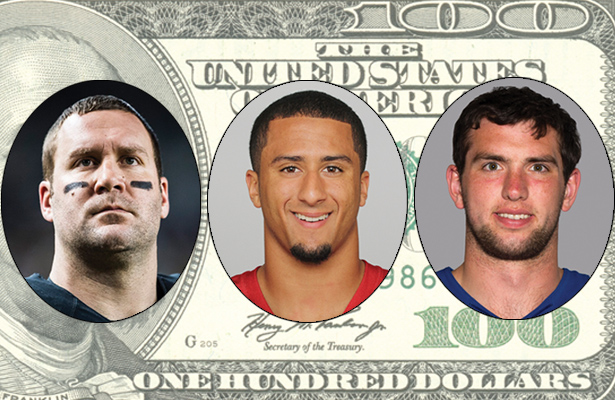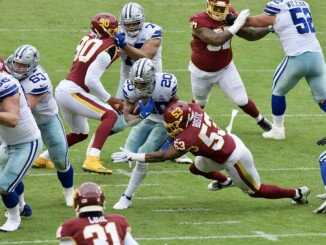
Somewhere around the fourth grade, the basic division of numbers is learned in arithmetic. That’s when 10-year-old kids always have been able to take a number like 126 and divide it by 6. It’s simple mathematics, with a simple answer of 21.
This answer is universally correct in every walk of life, in every corner of the world…except the world of the National Football League player contract. You see in this world, 126 divided by 6 could possibly equal 10.17 or even 2.17. Allow me to explain the complex nature of what is called ‘NFL Contract Mathematics’ to you.
The Contract of Colin Kaepernick
During the 2014 off-season, the San Francisco 49ers inked their young promising quarterback Colin Kaepernick to an eyebrow-raising six-year, $126 million deal. Those like me who are pretty good with numbers were quickly able to average out his annual take by that simple division we learned back in fourth grade.
Colin Kaepernick will be making an average of $21 million a year by that equation. Well, hold your horses right there. He really won’t average that hefty sum. You see, only $61 million of that $126 million is “somewhat guaranteed.” With annual roster bonuses and assumed attainable performance incentives, he just might see that $61 million.
After that simple division is done, you come up with an annual average of $10.17 million. Again I ask you to pause because there’s more to this contract. If the 49ers decided today to cut ties with Kaepernick based on performance, the “somewhat-guaranteed” $61 million is reduced to its “fully-guaranteed” $13 million. Apply fourth grade division again and it averages to $2.17 million annually.
Unlike its brethren in other American professional sports, the NFL has never operated on guaranteed contracts for its players. In the sport with the shortest player life span, due in part to its physicality and the ensuing injuries, contracts basically are written in invisible ink. A New York-based financial firm reported that the average guaranteed money for all players in 2014 was only 57 percent. That number didn’t take into consideration all the “partially-guaranteed” deals players will find hard to see the end of before being released to the streets.
The Collective Bargaining Agreement (CBA) has a ‘fully-funded’ rule that has been retained for years. Guaranteed contracts were never negotiated when owners and the NFL Players Association came together to iron out labor issues.
“Many of the teams cite that rule in their unwillingness to put the full amount (of the player’s contract) in escrow,” said NFLPA Executive Director DeMaurice Smith.
Nothing in the CBA as currently written either requires or prohibits guaranteed contracts. NFL owners always have just opposed the idea so demonstratively that attempts to bring it into talks now are futile.
Pittsburgh Steelers quarterback Ben Roethlisberger’s recent extension of $64 million guaranteed over four years is the largest amount in league history. The Miami Dolphins signed Ndamukong Suh away from the Detroit Lions for a cool $114 million over six years, with $60 million guaranteed, the largest guarantee given to a non-quarterback in league history.
Owners became weak in the knees upon learning of these massive guaranteed contracts. Fear of it being the start of a negotiating trend among looming high-end free agents, they are hoping those two are isolated situations. The idea of tying up millions in a player who could blow out a knee or who no longer can play due to a decline in ability. That’s why they always have favored contracts with a stimulated “signing bonus,” the only amount the player is guaranteed to earn. The common practice of then structuring the contract with an array of incentives, escalators and de-escalators makes up the remainder of all future monies the player could earn. Anything but a large sum of guaranteed cash works for the owners.
How About the NBA?
The National Basketball Association opened its free agency period on July 1. Within the next 24 hours, $1.4 BILLION in GUARANTEED money was tentatively agreed upon between players and teams. With that came the realization that an average NBA player like Robin Lopez, who signed with the New York Knicks, would make the same guaranteed salary ($54 million) as perhaps the NFL’s best player in Green Bay Packers quarterback Aaron Rodgers will deposit into his account.
Why is it NBA owners don’t have the same reluctance to guarantee deals like their NFL brothers, knowing the same chances of injuries and decline in play exist in their sport? It is said the life expectancy for basketball players extends well beyond that of a football player. Signing a 28-year-old running back, a position of quick flame out, to a long-term huge deal could be the beginning of ‘salary cap Hell’ for an NFL organization. Meanwhile, the San Antonio Spurs just handed over $80 million to 30-year-old LaMarcus Aldridge.
NFL owners will make the point that the NBA can afford to guarantee contracts due to rosters with only 13 players per team, about one quarter of their 53-man roster. Also the revenue generated by 41 home games makes those deals doable they would say, way more than the eight regular season and two preseason games they generate to make money to cover contracts. Quite frankly, it would take the Dallas Mavericks until around Christmas to make what the Dallas Cowboys make off of a single home game so NFL owners could easily guarantee their players’ deals.
There are those who side with the owners that guaranteed contracts would have a negative effect on the game. Before 2011, it was the rookie deals that irked veteran players. They balked at giving huge amounts of guaranteed money to unproven players, leaving the teams with less to pay them.
Since the CBA capped rookie deals in 2011, opponents of guaranteed deals feel like it would be an inverted effect of the old rookie contracts. If a player is signed to a huge guaranteed deal and toward the end he is a shadow of his former self, it still would be unfair. Would it be fair to the young player contributing more to the team to be unable to receive pay commensurate to their abilities because money is tied up in the 35-yearold veteran he has replaced?
It is believed owners like having non-guaranteed contracts so veterans continue to work hard to ensure their high production levels so the team keeps them around.
What to Expect
With the looming lawsuits from former players, moving toward guaranteed deals as a valiant attempt at making amends for how retired players were treated could be on the horizon. Maybe shorter-term guaranteed deals would address the problem. This would allow ownership the luxury of getting out of a deal quickly if the player gets hurt or fails to live up to the contract. They won’t have to deal with “dead money” consuming cap space for very long should that happen. It also would allow players more financial flexibility to reach free agency more often in their prime years to take advantage of their greater earning potential.
Indianapolis Colts quarterback Andrew Luck is approaching free agency. He is the league’s poster child and will be for the next decade at least. I will be curious about how much money he is guaranteed with his next contract. Could it be 100 percent? Probably not, this is the NFL.
Luck will be a wealthy man nonetheless, we just won’t know how wealthy based off what will be guaranteed. Just know that the division you learned in your adolescence won’t apply to what you read his contract to say.
Understanding high school calculus has proven to be easier than figuring out NFL contract mathematics.




